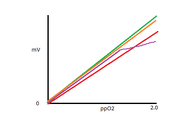The SB threads you linked on TDF had a bunch of posts by me so I thought I would try to clear this up. E.g. like this one
Calibration question
I have lost ppO2 output on a cell due to corrupted flash memory. I discovered it on the surface. I had mV but no ppO2 at all. I recalibrated and it fixed it. Sent the head in and they reflashed the memory for me but otherwise there was nothing "wrong". Normally I don't look at mV output on a dive.
Regarding calculating what your "expected mVs should be" this is something I was taught twice. In my original TDI MOD1 with my Meg and again in my PSIA Kiss crossover. There is no way to confirm linearity in the water. You can confirm cells aren't current limited but this is not the same thing.
Short of putting your cells in a pot, there is no way to test for linearity but there can be hints of a failing cell at calibration. There should be a 1:4.78 relationship (1/0.209 = 4.78) between mV in air and mV in 100% O2. If the mVs don't rise proportionally, the cell is out of spec. 100% should be 4.78x the mV of air. Calibrating an out of spec cell is masking a problem.
To illustrate crudely:
Green line is a "perfect cell"
Orange is a good cell
Red is an out of spec cell that is linear but not performing as adequately. A deviation of more than 3% between ideal and expected for this kind cell in 100% O2 at calibration will mean that you will get 1.3 on your handset but the true O2 is at ppO2 of 1.4 (not fatal but more than 3% is a reject). You can even spike the red cell to 1.5. It is not current limited in an
immediately dangerous way
Purple is linear then becomes current limited. It will never reach 1.3, 1.4 etc. The inflection point moves lower and lower as the cell gets worse and worse. Red type cells eventually turn into purple cells.
Checking that mVs are as expected in 100% is an effort to catch cells behaving like the red one. Spiking to 1.4+ briefly on a dive is trying to catch cells like the purple one. There is rarely a "usual" cell but I have had far more cells gradually go out of spec with the red line shifting lower and lower vs detecting any pronounced inflection point from current limiting. I change all my cells at 12 months which is probably why I have never gotten to the point of having a purple cell, I have seen lots of cells gradually perform poorer and poorer as the red line shifts down - still linear just going out of spec compared to the ideal green line.
The easiest way to check that your cell isn't "too bad" yet on the spectrum of red cells (assuming they don't fail abruptly, all good cells eventually go red like before they get to the really bad purple stage) is to confirm that your mV in 100% O2 is close to what they "should be" based on where they started in air. Since using a pressure pot isn't part of any MOD1 courses that I know of, that's why verifying that your cells are linear in the air to 100% range is part of calibrating in both my MOD1 and my crossover with different agencies and instructors. 3% deviation from expected sounds small but ends up being a shift of 0.1 ppO2 units after calibrating when you're trying to dive in the 1.2-1.4ish range.
(ps I know there exceptions, the figure and explanations were an effort to simplify)





